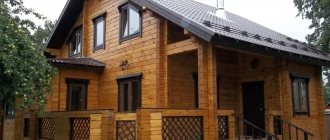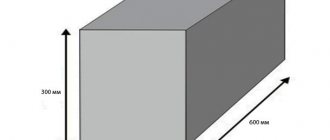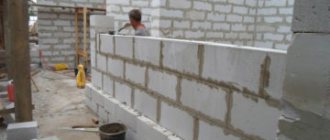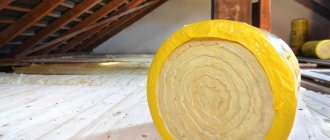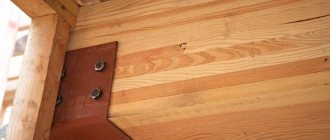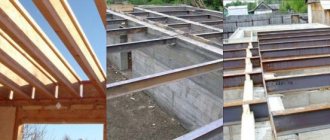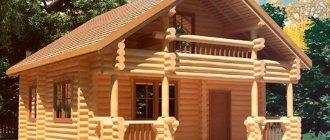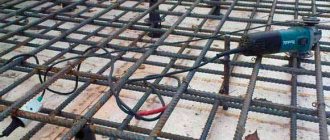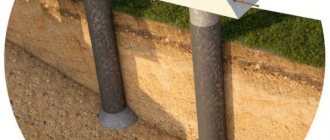What is basalt insulation, characteristics and applications
Types of basalt insulation
Depending on the purpose, various modifications of basalt wool are produced:
- Soft wool
is not designed for significant mechanical loads, but due to its porous structure, it is one of the most effective heat insulators. - Medium strength slabs
are designed for insulation of ventilated facades, sound insulation and protection of air ducts from open fire in case of fire. The thermal insulation properties of the material are no worse than those of soft wool, but the cost is significantly higher. - Rigid basalt slabs
are able to withstand significant mechanical loads without losing their thermal insulation properties. They are used for insulating floors, for exterior work and for insulating frame partitions. - Foil-coated basalt wool
not only contributes to thermal insulation, but also reflects some of the heat back into the room. Basalt insulation can be covered with a layer of foil on either one or both sides. When using BV with one-sided foil, the material is placed with a reflector inside the room.
Important!
Both rolled and sheet basalt wool has minimal thermal conductivity and ensures sufficient air circulation.
How is stone made soft and fluffy?
Let's reveal a secret: to turn a real stone into soft cotton wool, it is melted in an oven at a temperature of 1300-1500 degrees Celsius. Only at this temperature does basalt become liquid. It drips into a rapidly rotating large flywheel, or immediately seeps through micro-holes into the centrifuge - depending on what technology is used in production.
There, organic matter is added to the fibers formed from the droplets. Fibers under different pressures are formed into mats and slabs. This is how stone wool reaches its final microstructure and density:
In real life this process looks like this:
Interesting, isn't it?
Advantages and disadvantages of basalt insulation
Using basalt wool as thermal insulation has a number of advantages:
Thermal conductivity
material is extremely small and can range from 0.032 – 0.048 W/m 0K. For comparison: 10 cm thick basalt insulation will replace:
- 25.5 cm natural wood;
- 117 cm ceramic bricks;
- 160 cm clay brick;
- 200 cm of silicate masonry.
At the same time, the specific gravity of BW will not exceed 100 kg/m3.
Moisture resistance of the material
. Basalt insulation absorbs no more than 2% water per unit volume. The hydrophobicity of the material allows it to be used for thermal insulation of objects with high humidity: building foundations, baths, saunas, etc.
Vapor permeability
at the level of 0.3 mg/ (m h Pa) provides a comfortable microclimate. Thanks to the porous structure, moist air is able to freely pass through the insulation layer without affecting the thermal insulation properties of the material.
Fire safety
basalt wool according to GOST 30224 belongs to the NG group (non-combustible materials). In addition, BV can prevent the spread of open fire and has a resistance limit before melting of 11140C.
Soundproofing characteristics
basalt insulation allows you to provide an acceptable degree of comfort.
Mechanical strength
during compression, depending on the modification, it can fluctuate between 5 and 80 kPa. Thanks to the specific arrangement of the fibers, even not the most durable brands of stone wool are able to withstand significant loads without collapsing.
Resistance to chemical and biological influences
makes it possible to widely use stone wool for thermal insulation of special objects. Insulation made from basalt fibers does not interact with chemically active compounds, is resistant to rodent attacks and does not contribute to the development of mold.
Environmental Safety
The material is due to the use of natural raw materials. Binding components containing formaldehyde resins do not emit phenol, since they are neutralized during the production process.
Long service life
is a consequence of the optimal combination of the above properties.
As for the disadvantages, it can hardly be attributed to them the need to work with gloves and a respirator, since this is not a weak link, but basic safety rules that have not yet been canceled, and they apply not only to basalt insulation. Complaints about the presence of seams are more reminiscent of baby talk than justified claims, since a monolithic heat insulator has not yet been invented, any insulation has to be joined.
The relatively high cost is fully justified by the performance properties and service life, and the material is simply not intended for thermal insulation of plinths and basements.
Basalt insulation: sizes and price
Depending on the manufacturer and purpose, basalt material may have different characteristics:
| Manufacturer | Size, mm | Specific gravity, kg/m3 |
| TechnoNIKOL | ||
| Technofas | 600*1200*50/100 | 145 |
| Technoven | 600*1200*50/100 | 80 |
| Knauf | ||
| Insulation FKD | 600x1200x20 – 160 | 140 – 150 |
| Insulation FKL | 200x1000x20 – 200 | 85 |
| Insulation FKD-S | 600x1200x60 – 180 | 140 – 160 |
| Insulation HTB | 1000x500x20 – 180 | 35 – 150 |
| Rockwool | ||
| Fasrock | 1000x600x100 | 135 |
| Wentirockmax | 1000x600x50 | 50 – 90 |
| Panelrock | 1000x600x50 – 100 | 65 |
The average cost of basalt insulation ranges from 450 rubles/0.3 m3, rolled material costs 150 rubles/kg. To insulate the roof with stone wool you will have to pay 1,700 rubles/m3. If formaldehyde resins are not used in the production process, the cost of the material will increase to 1300 rubles/m3, and foil material will cost 300 rubles/m2.
Ecowool or basalt insulation, which is better: comparative characteristics
Before making a decision, it is necessary to carefully study the features of a particular heat insulator. For clarity, here is a comparative description of ecowool and basalt insulation:
| Characteristics | Basalt insulation | Ecowool |
| Thermal conductivity, W/m*K | 0.038 | 0,032-0,041 |
| Moisture absorption,% | 1 – 2 | According to GOST 17177.5 Within 72 hours - 16% |
| Specific gravity, kg/m3 | 10 – 15 | 25 – 50 |
| Vapor permeability, mg/(m*h*Pa) | 0.32 | 0.68 |
| Fire safety | non-flammable | moderately flammable |
| Adhesion to the base | Possible cavities | Absolute |
| Gap between plates | Occurs due to poor quality installation | No |
Next, you should take into account the labor intensity of the work, which is significantly higher when using ecowool. The cost of 1 m3 is approximately the same and ranges from 1300 to 1700 rubles.
Conclusion:
in the event that adherence to the base is of fundamental importance, ecowool should be used; in all other cases, it is more advisable to use basalt insulation boards.
Choosing insulation for a private home: is it worth searching for a “super material”?
Affiliate Material
First, let's talk about how people choose high-quality, expensive, absolutely flawless and absolutely reliable insulation, but then become hopelessly disappointed in its performance. And the most offensive thing in this situation is that the selected material in practice actually corresponded to the declared characteristics.
We won’t go far: let’s look at an example from the forum. On the advice of “experienced” builders, one family decided to insulate their frame walls with prestigious extruded polystyrene foam (EPS). The material chosen was branded, quite expensive, and everyone who dealt with it shared favorable reviews. The unsurpassedly low thermal conductivity values looked promising and in practice really justified the trust with the “penny” heating costs. The only problem is: the wooden frame began to become moist and rot almost in the second year of operation.
The reason for the trouble turned out to be trivial: the insulation did not match the area of application. In frame construction, EPS has only two areas of application. This is foundation insulation and floor insulation. The insulation of frame walls with polystyrene foam led to a disruption of the structure of the frame pie. The fact is that in frame construction the vapor permeability of the material should increase layer by layer - in the direction from the inner layers to the outer. The vapor permeability of the EPS turned out to be zero, condensation began to form on its side edges, the frame became wet from the condensation, and the result was what happened.
Conclusion: price (if it is above average) is not always synonymous with quality. The same can be said about the popularity of the brand, which makes the material very popular among builders: these are by no means criteria that should be followed unconditionally. The choice of insulation should largely depend on the type of building structure and the characteristics of the material from which it is created. Moreover, it is impossible to choose a universal insulation that would suit any situation equally well.
Elena PashkovaGeneral Director of STM LLC
By definition, universal insulation cannot have stable performance parameters. Under some conditions it should be characterized by high strength, rigidity and absolute moisture resistance, under others - flexibility, the ability to transmit steam and low density. These are mutually exclusive requirements, which is why there are no materials in the world that are equally effective under different operating conditions. However, it is worth highlighting the characteristics that should always remain a priority when choosing insulation. We are talking about the coefficient of thermal conductivity (which should be as low as possible), environmental friendliness (which can be characteristic not only of natural, but also artificial materials) and durability. It would be nice if all of the above came with an affordable price.
Selecting insulation according to its technical characteristics
As we have already found out, there are no completely universal insulation materials. But since the users of our portal are mostly interested in insulation materials used in the field of low-rise construction, we can highlight a separate line of technologically advanced, lightweight and at the same time inexpensive materials (suitable for the construction of private houses, dachas and cottages). These are mineral wool insulation materials. Manufacturers, by changing their characteristics (density, sound permeability index, etc.), make the material suitable for use in various building structures.
Thermal conductivity
It is quite logical that the thermal conductivity coefficient is one of the key characteristics of mineral insulation. The lower it is, the better the material’s ability to retain thermal energy. Among mineral insulation materials, the lowest thermal conductivity coefficient (0.034 - 0.039 W/m°K) has basalt wool, made from the same material.
For comparison: for slag wool this indicator varies between 0.046 – 0.048 W/m°K.
The thermal conductivity coefficient of glass wool starts at 0.030 W/m°K and can reach 0.052 W/m°K. It all depends on the density of the material. The key disadvantage of glass wool is its lack of durability. In addition to this, it is susceptible to matting and weathering. Glass wool begins to melt at 600°C (for comparison: the minimum melting temperature of stone wool is 1000°C, but as a rule it is higher). The listed features are more than compensated by the low price of glass wool, which allows the material to be used in large volumes in the construction of large facilities (for example, industrial or warehouse).
Density
Density is an indirect guideline when choosing insulation, which largely determines the load on the insulated structures. In this case, the thermal insulation itself can be loaded or unloaded. Examples of non-load-bearing systems: heat and sound insulation of pitched roofs, interfloor ceilings, floors on joists, frame partitions, etc. Insulation with a low density, for example, 25 - 30 kg/m³, is suitable for their organization. Loadable systems are thermal insulation under a floating screed or a serviceable roof.
When creating thermal insulation under a screed, for example, dense insulation of special series (including mineral wool) is used, which can suppress impact noise.
In this case, when choosing, the main attention is paid not to the density of the insulation, but to its main purpose. Such material can withstand the weight of a relatively heavy coating and does not deform, maintaining its fibrous structure. This helps it retain heat and dampen sound vibrations.
However, an attempt to make unloaded structures soundproof by using too dense mineral wool will certainly result in overpayment due to the undesirable effect of high heat loss. The fact is that the denser the insulation, the higher its thermal conductivity. In addition, dense insulation is not always synonymous with soundproof insulation, because sound is best damped by a material whose density lies in the range of 40–50 kg/m³.
Conclusion: you cannot choose insulation based solely on its density. The task should be reduced to finding the optimal option that will provide a sufficient level of heat and sound insulation, but will not overload the load-bearing elements of the insulated building system.
Acidity module
When choosing insulation, each of us will certainly think about the durability of the material. The durability of mineral wool is largely determined by such an indicator as the acidity modulus. In the language of chemists, the acidity modulus expresses the ratio of the total volume of acidic oxides in a material to the volume of basic oxides (as a percentage by weight). In simple terms, this is the ratio of stable and chemically active substances. Manufacturers of mineral wool, as a rule, do not talk about this, however, the higher the acidity modulus of the raw material, the more chemically stable, and therefore more durable, the material produced from it will be.
The raw material for the production of glass wool or slag wool, which can serve for decades, however, has a lower acidity modulus (compared to basalt rocks). This means that stone wool is the most durable material of all mineral insulation materials. Its service life is 60 years or more.
The “Three E” principle when choosing insulation
Rigidity, hygroscopicity, fire safety and sound permeability of the material - the buyer is recommended to pay attention to the listed characteristics without fail. In some cases, the manufacturability of the insulation (ease of installation and preparation of the material for use) may be decisive. This happens when installation of insulation is inconvenient due to the particular complexity of building structures. It is also necessary to pay attention to the comparative advantages of this or that insulation over its analogues.
Representatives of the HotRock company, which produces basalt insulation for apartments, private houses and various commercial facilities, reflected the advantages of their products in the “Three E” principle. It is based on three components: environmental friendliness, economy and efficiency. Guided by this principle, as well as the technical characteristics of the material, everyone can choose insulation that meets their needs.
Let's decipher the basic components of the principle.
Economical:
- All materials are produced in the Smolensk region, which allows minimizing delivery costs to the Russian consumer.
- No overpayment for the brand.
- Guaranteed reduction in space heating costs when using HotRock insulation (costs are reduced by 30%).
- The guaranteed service life of the material exceeds 50 years, during which the owner of the premises will not have to worry about purchasing and replacing insulation.
Environmental friendliness:
- All types of HotRock insulation consist of more than 90% natural raw materials.
- The basalt base is absolutely safe for the human body, while rodents prefer to avoid stone wool.
Efficiency:
- The thermal conductivity coefficient of HotRock insulation starts from 0.034 W/m°K, which is one of the best indicators noted on the Russian market.
- The index that determines the degree of sound insulation is 53 dB, which is also an extremely high indicator for the Russian market.
In addition to all of the above, insulation materials are protected from ignition and prevent the spread of fire.
As we have already said, it is impossible to find a universal insulation. However, there is nothing easier than building a house and auxiliary premises on the site, using various modifications of heat, sound and moisture insulation materials from the HotRock company.
Description and properties of basalt wool
Externally, basalt wool is a grayish or beige mass of needle-shaped fibers approximately 5 centimeters long and thickness measured in microns. Mineral threads are scattered randomly, which ensures the strength and flexibility of the material.
It doesn't always look like cotton wool. The external impression depends on the density of the fibers. Sometimes they are so close to each other that the insulation is more reminiscent of slabs from waste wood processing or, rather, mattresses made of coconut fiber.
In industrial conditions, the heroine of the article is produced by blowing basalt melt. They use waste stones and fragments from quarries. They are cheap and easier to melt down. Blow out the cotton wool with a stream of air under pressure.
The process takes place in closed units. The first samples were obtained using the open method. However, once in the air and cooling in it, small “needles” of the stone entered the workers’ respiratory tract, causing irritation. Basalt also tends to get into your eyes. Therefore, they work with cotton wool in thick suits, gloves and safety glasses.
Basalt mineral wool , as well as its origin, borrowed its properties Like all stones of the class, it is not afraid of water. There are exceptions in other categories. Sedimentary rocks, for example, include limestone, gypsum and rock salt, which absorb moisture.
Since basalt wool is made of stone , it is ignored by rodents, insects, and mold fungi. The mineral environment is not nutritious for them. However, the heroine of the article is considered as housing.
Rats, for example, are capable of denting passages in loose insulation samples. It becomes a home without being food. Therefore, it is important to isolate access to mineral wool.
Basalt threads laid with air layers between them reduce the thermal conductivity coefficient to 0.4 W/m*K. Atmospheric gases are impervious to temperature. This is why air-filled wool mittens and sheepskin hats are the warmest.
In down jackets, the hero is not so much the down itself as the space between it. The same applies to mineral wool. The basalt in it is just a frame for air, and it is environmentally friendly. In addition, the elasticity of the stone threads allows the insulation to keep its shape. Placed, for example, in the walls, cotton wool does not slip or compact over time.
The characteristics of basalt wool also include fire resistance. All stones are distinguished by it, except coal. But, there is a caveat. In addition to basalt and air, the heroine of the article contains resins. They glue mineral fibers together. Organic resins, with a combustion temperature of up to 200 degrees.
Stone threads can withstand even 1300. Conclusion: after 200 degrees, only 2 components remain from the material. Basalt wool is still used, but is no longer what it used to be. Fiber bonding decreases and compaction and shedding may begin.
The resins in the insulation make you wonder whether basalt wool is harmful or not . Igneous rock is environmentally friendly. There is no catch from the air. But what resins are included in the insulation? Only one thing is clear, they are phenol-formaldehyde.
Phenol, after which the compounds are named, is a carcinogen. The substance is poisonous, irritates the nerve centers and paralyzes the respiratory tract. The safe content of phenol in the air is 1 milligram per cubic meter.
In addition to mineral wool, the substance is present in resins that fasten fiberboard, chipboard, plywood, OSB boards, many varnishes and some adhesives. In general, in a modern home there are many opportunities to surround yourself with phenol. It is reassuring that the heroin in the article contains only 5-10% resins. The poison of this amount is about 3%.
Specifications
The material has the following features:
- Non-flammability. Withstands up to 1000°C and exposure to open fire. It consists of volcanic rocks, so this feature is easily explained. The product retains heat well and insulates heated air. This function is widely used for insulating pipes through which hot water or other high-temperature compounds pass.
- Hydrophobicity. The material can be used indoors. Where the humidity level is high. One of the properties of cotton wool is to repel water. Basalt wool insulation is installed in swimming pools and bathhouses. Basalt wool is slightly harmful to health, or harmless at all. It is worth taking this into account when insulating residential premises.
- Vapor permeability. The characteristic explains the ability of the material to pass air flows. Moist steam passes through the basalt, creating a positive microclimate in the insulated rooms.
- Soundproofing. Sound waves are delayed by the volcanic rocks contained in the structure. The composition can be used not only as insulation, but also as a soundproofing material.
- Strength. The fibers are arranged randomly, which is why cotton wool has high strength. Even after exposure to heavy loads, it is possible to restore the original shape.
Comparative table of characteristics of insulation materials
Parameter name Slag woolGlass woolMineral woolBTV
| Maximum temperature of use, o C | Up to 250 | -60 to +450 | -60 — +600 | -190 — +700 |
| Average fiber diameter, µm | 4—12 | 4—12 | 4—12 | 5—15 |
| Humidification per day, % | 1.9 | 1.7 | 0.095 | 0.035 |
| Taunting | + | + | – | – |
| The need to use a binder | + | + | + | + |
| Thermal conductivity coefficient W/m*k | 0,46—0,48 | 0,38—0,046 | 0,077—0,12 | 0,038—0,046 |
| Presence of binder, % | From 2.5 to 10 | From 2.5 to 10 | From 2.5 to 10 | From 2.5 to 10 |
| Flammability class | NG - non-flammable | NG - non-flammable | NG - non-flammable | NG - non-flammable |
| Release of harmful substances | Yes | Yes | Yes | Yes, if there is a binder |
| Heat capacity | 1000 | 1050 | 1050 | 500—800 |
| Vibration resistance | No | No | No | No |
| Compressibility | 60 | 60 | 40 | 40 |
| Elasticity | 50 | 55 | 60 | 71 |
| Sintering temperature | 250—300 | 450—500 | 600 | 700—1000 |
| Fiber length | 16 | 15—50 | 16 | 20—50 |
| Sound absorption coefficient | 0,75—0,82 | 0,8—0,92 | 0,75—0,95 | 0,8—0,95 |
| Chemical stability in water | 7.8 | 6.2 | 4.5 | 1.6 |
| Chemical stability in alkaline environment | 7 | 6 | 6.4 | 2.75 |
| Chemical stability in acidic environment | 68.7 | 38.9 | 24 | 2.2 |
Stone wool can withstand many types of chemical and biological influences. Mold and mildew do not form on the surface, and infection does not spread. It will not react with nearby compounds. Basalite, whose technical characteristics are very high, is considered one of the best insulation materials.
Pros and cons of the material
High-quality wool, stone or basalt, has a number of advantages. It is able to withstand significant temperatures and changes. After heating, no harmful substances are released into the atmosphere. The composition does not attract pollution and tolerates it steadily. The slabs are easy to transport and convenient to install.
In addition to the listed positive characteristics, there are advantages:
- Long service life. The ability to retain heat remains, according to manufacturers, for 50 years. Properties are not lost during the specified time.
- The walls become almost soundproof. Thanks to the successful structure, the waves are damped.
- The material is not exposed to mold, rodents, or the spread of fungus on the surface.
- Minimum weight. You can create a light foundation thanks to the property.
- Resistance to physical impact. It is unlikely that it will be possible to change the shape of the slabs due to the arrangement of the fibers.
- High degree of moisture repellency.
Basalt wool, whose characteristics are very high compared to other materials, has certain disadvantages that should also be taken into account when choosing. These include high cost. In addition, due to the shape of the product (slab), many beams will have to be laid and seams formed.
Important! If the insulation at the joints is insufficient, the entire work will be of poor quality. There is a possibility of deformation of the composition, after which the work will also not be crowned with success.
When working with insulation, be sure to use protective equipment. The minimum is glasses to protect your eyes from falling particles. Insulation foil-coated on both sides does not have this drawback.
To prevent the steam that cotton wool can absorb from remaining inside and reducing performance characteristics, an additional layer of vapor barrier and wind protection are required.
Nuances of use for wall insulation
Installation work must be carried out at an ambient temperature of +5°...+25°C and a relative air humidity of no more than 80%. When installing soft panels, do not expose the material to direct sunlight. To insulate the outer surface of the walls, it is recommended to use ready-made slabs, which simplify the process of mating joints. To complete the work you will need finishing materials, carpentry and measuring tools and an electric drill or hammer drill.
Preparatory activities
Main activities at the pre-installation stage:
- Clean the walls from dirt, mold and old peeling plaster or loose paintwork. Remove the nails and seal the breaks and cracks with foam or tow.
- Impregnate the surfaces with a primer with antibacterial additives and cover with a material that improves the adhesion of the adhesive composition.
- Attach plastic film to the wall surface.
- Fasten the vertical frame elements in increments of 10-15 mm less than the width of the sheets. The insulator must fit tightly into the gap between the beams, otherwise the walls of the house are cooled through the cracks.
Installation Tips
During installation, the material is inserted into the gap between the profiles; special glue or plastic dowels with washers are used for fixation. According to statistics, to hold a slab with an area of 1 m², it is enough to install 6 fasteners. There should be a membrane on top of the insulator to protect it from wind loads; the film is overlapped and the seams are sealed with tape.
If the façade is to be finished with siding, then additional sheathing must be installed on top of the basalt wool (the elements are placed at right angles to the main frame).
Finishing
At the finishing stage, the plastered insulator sheets are covered with a layer of paint, and the surfaces are pre-treated with sandpaper to increase adhesion. To ensure durability of the finish, a ventilated facade made of siding or panels made of natural or artificial stone is installed on top of the basalt wool. The air gap between the insulation and the external finish ensures air circulation and removal of water vapor.
Application of basalt wool
The resistance of the heroine of the article to moisture and fire makes the insulation universal. It is used both inside houses and on their facades. Insulation with basalt wool is relevant for baths, pipelines and metal structures, chimneys. In the latter, the material serves as a thermal barrier, preventing the fire of materials adjacent to the pipe.
The heroine of the article insulates not only the walls, but also the ceilings and floors. The main thing is to choose the right density of basalt wool . On floors subject to stress and vibration, for example, compacted sheets are needed.
The loose ones here will still thicken over time. On the walls, airy cotton wool will do. We're talking about interior decoration. On the facade, dense sheets are needed. These can be coated with plasters.
Also, foiled basalt wool . The coating on it provides additional protection from moisture. The insulation still absorbs some water, and in façade systems contact with vapor is common.
With the correct selection and installation of wool, it will last at least 30 years. These are the manufacturers' guarantees. In fact, the insulation does not “remind” itself for 50-70 years. Consumers are captivated by the verifiability of the numbers, since the production of the heroine of the article is almost a century old.
Areas of application of insulation based on basalt fiber
Basalt slabs are used for insulation of building facades, partition structures, floors, roofs and other building structures. In addition to residential buildings, basalt insulation is used on industrial sites. Most often used for insulating frame houses.
Having studied the technical characteristics, it is easy to come to the conclusion that mineral insulation can be used in almost all areas of construction. Due to its fire resistance, it is recommended to be used when insulating a building that requires a high degree of fire safety.
Low water absorption makes it possible to use insulation when insulating a bathhouse or sauna. When choosing, remember that the weight of basalt insulation exceeds the weight of polystyrene foam or mineral wool.
Types of basalt wool
There are several types of basalt wool. By and large, the differences are insignificant, but thanks to them you can select exactly the material that is needed for the job as correctly and accurately as possible. In fact, basalt wool has the following types:
- Soft. This material has a relatively low density and is recommended to be used where there are no heavy loads. This insulation is suitable for ventilated facades, soundproofing walls using the frame method, as well as similar types of work. The soft structure of wool is obtained not due to the loss of material qualities, but as a result of using thinner fiber.
- Medium hardness. Medium-density basalt wool is used in the formation of ventilated facades. In fact, it can be used in the same way as soft material, but there will be an overconsumption of material, and in production and in home use, overconsumption leads to a loss of money.
- High rigidity. This material is applicable in cases where the insulation is exposed to large mechanical loads. It is this wool that will be used for insulating the facade with further reinforcement and plaster. Cotton wool can withstand high loads without losing its shape and characteristics. Also, hard basalt wool is used for insulating floors with further screed filling.
- Basalt wool with foil base. This material is considered the most effective heat insulator. A layer of cotton wool retains heat, and thanks to the foil, warm air returns to the room. When mounted to walls, the foil must be in contact with the surface; only in this form is it considered most effective. The scope of application of the material is quite wide, because it can be used for various purposes.
The only difference between basalt wool is its thickness. Depending on this indicator, the characteristics of the material may vary. The thicker the layer of cotton wool, the better it retains heat. For use in apartments, they mainly use material with a thickness of no more than five centimeters. This is quite enough to get the expected effect of sound and thermal insulation. Basalt wool is produced in rolls and slabs. Depending on the need, you can choose the most suitable option.
Basalt wool - and this is possible
Since this insulation is one of the types of mineral wool, it has several names, including basalt or stone wool. Moreover, it not only surpasses all other types of mineral wool in terms of strength characteristics, but is also absolutely safe for humans and nature. Compared to mineral wool made from metallurgical slag, basalt insulation is more environmentally friendly, easier to cut and install, and lasts longer.
Molten gabbro-basalt rocks, forming thin fibers, form the basis of basalt wool. By and large, this is fiberglass, but not from quartz, but from basalt. And this material was invented (or rather, noticed) by the Hawaiians. Once, when one of the volcanoes once again erupted lava and cooled down, local residents found amazing fibers, long and strong, in the remains of the lava. Later, what was done by nature, people were able to repeat it, inventing the production of basalt fibers.
The volcanic rock is basalt.
To do this, the rock must be crushed and melted. The temperature in the melting furnace is very high - 1500 degrees, no less. Then the melt enters special drums, where it rotates, blown by an air stream. The result is fibers whose thickness is no more than 7 microns and whose length is no more than 5 centimeters. To make the fibers elastic and strong, a special compound is added to bind them. Then the cotton wool is heated to 300 degrees, passing through a press 2 times.
Basalt wool price
The price of basalt wool depends on the degree of compaction and type. There is also a premium for brand awareness. Thus, Rockwool basalt wool costs about 2,000 rubles per cubic meter.
For products from little-known companies they charge about 25% less. The location of the company also plays a role. TechnoNIKOL basalt wool , for example, is domestic. You can save about 15%.
Foil cotton wool is more expensive than regular cotton wool. When it comes to forming material, cylinders are the most valued. For an aluminum-coated sample 21 centimeters long and 4 centimeters wide, you will pay, on average, 600 rubles.
For the same money you can buy 4 slabs measuring 120 by 60 by 10 centimeters. It also happens that cotton wool is 5 centimeters wide. It is taken for moderate climates and buildings that do not require extreme insulation.
Material properties
Stone or basalt wool has good thermal insulation properties due to the air statically enclosed in the pores of the material. At the same time, open pores allow water vapor to pass through. Depending on the degree of compaction, the specific gravity is 30-220 kg/m³, and physical and mechanical characteristics vary depending on the density.
For example, slabs with increased rigidity can withstand static loads of up to 700 kg/m². To improve performance, a layer of foil, fiberglass or thick paper is applied to the surface.
Fire resistance
Basalt fiber is characterized by increased fire resistance, the maximum heating temperature is +1114°C. An open fire does not ignite the slabs, but when heated above +870°C, the mineral base and filler begin to melt. Due to its increased temperature stability, the material can be used for thermal insulation of chimneys or lines for supplying superheated steam.
Hydrophobicity
The dense structure of wool reduces the penetration of water into the inner layers. Additional basalt fibers, arranged in a chaotic manner, improve the insulator's resistance to liquid exposure. The average moisture coefficient is 0.035%, which is 3-4 times lower than that of classic mineral wool with glass or slag filler.
Basalt wool helps reduce water penetration into the inner layers.
Is basalt wool harmful to health?
Particular interest in the degree of harmlessness of basalt wool is caused primarily by the fact that the material is actively used as insulation. People come into contact with it, so it is important to know whether the composition poses a threat. If you look at the question objectively, the material does not pose any threat, it is environmentally friendly.
Previously, glass wool was widely used as an insulating composition, which could really cause irreparable harm to health. Basalt insulation cannot be compared with it. The harm to health depends entirely on how well the insulating layer is made. If it is not there, then the material may cause certain problems.
The main problem with basalt-based products is that they can crumble during installation. If the worker is not wearing protective elements (gloves, respirator, goggles), tiny particles may enter the lungs and result in an allergic reaction. Once on the body, the particles can cause itching.
Important! If it gets into the eyes, there is a risk of damage to the mucous membrane.
Above we are talking about materials where the protective shell is of minimal thickness and of poor quality. Purchasing high-quality insulation from a reliable manufacturer guarantees that no harm will occur. Usually the installation process takes place outdoors, so you won’t have to breathe air containing sharp particles. It is worth checking the quality certificate required for branded products.
After working with stone wool, you should wash yourself completely, paying special attention to cleaning your head. Gloves and other protective elements are unlikely to be washed. It is better not to use them anywhere.
About the disadvantages of basalt insulation
1. Everyone seemed to like this material. It is durable, retains heat excellently, and will not allow extraneous noise into the house. But it also has disadvantages, albeit few. First, let's mention the fairly high price. Unfortunately, not everyone can afford this wonderful natural insulation made from basalt fibers.
2. The presence of seams in those places where individual insulation elements are connected makes the insulating layer insufficiently airtight.
3. Despite the fact that basalt fibers are soft and do not prick your hands, tiny pieces may break off from them during the installation process. As a result, a column of tiny basalt dust rises from the heat insulator. And no one wants to inhale this dust - it certainly won’t help improve health. Put on a respirator before working with insulation - and everything will be fine. And to eliminate dust, the finished surface of the basalt wool is covered with a layer of waterproofing membrane.
4. Due to its good ability to transmit steam, in some cases it is not advisable to use this insulation and it is better to replace it with the same polystyrene foam. For example, when insulating the basement or foundation of a house.
Review of manufacturers, or what does the Russian market offer?
Let's look at which manufacturers today supply stone wool to the domestic market of insulating materials:
Knauf: recognized world leader
The most famous manufacturer of stone wool in the whole world is the German concern Knauf. He began producing products in 1932, and in the field of thermal insulation he mainly specializes in basalt fiber, although he sometimes produces fiberglass materials.
Knauf has a fairly well thought out choice of insulation for different house structures; for this purpose, they produce as many as five series: for the roof, and for the walls, and for the ceiling and partitions. Knauf also has universal mineral wool, which is suitable for any task:
Today Knauf produces stone wool literally for the whole world. But, unfortunately, buyers often complain about the increased rigidity of the slabs, which prick.
Of course, it’s not like glass wool; it’s more likely that there’s just an unpleasant sensation when working with bare hands. On the other hand, no one abroad would even think of working with cotton insulation without gloves.
Rockwool: high quality
No less famous is Rockwool - a Danish company operating since 1909. All its factories use only European equipment, which the company is especially proud of. Stone wool is supplied in the following forms:
By the way, Rockwool also has factories in Russia. Among other advantages of this basalt insulation, users usually note that it does not crumble or shrink, and also pleases with a wide selection of sizes and packaging. Those. It’s quite easy to choose the right option for building your home.
Ursa: expensive equipment
But Ursa have developed a new line of mineral wool. In fact, these are three entire production sites operating as the Ursa Eurasia association. Their main trump card is high-tech equipment. Previously, they worked more with fiberglass slabs, but today they use more natural basalt raw materials with acrylic-containing components.
Urs also has factories in Russia, namely in the city of Chudnovo. According to the manufacturer, new high-tech equipment from Europe was also imported there, and therefore you don’t have to worry about quality.
And Russia especially liked the Pureone series. By the way, this manufacturer’s basalt insulation is considered one of the best in terms of sound and heat insulation, although it has insufficient vapor permeability, as some complain.
TechnoNIKOL: for special loads
TechnoNIKOL is one of the most famous manufacturers of basalt insulation in Russia, producing its products under the Rocklight brand:
Interestingly, each TechnoNIKOL enterprise has its own laboratory. Thanks to this, multi-stage control is constantly carried out over the products. As a result, TechnoNIKOL received a European level certificate for its products.
And at one time, TechnoNIKOL modernized its production lines and was able to achieve a rather unique property of mineral wool - increased rigidity, thanks to which each basalt slab can withstand a load of up to 7 tons. The manufacturer is also trying to make the insulation unattractive to small rodents, since they really love such materials.
But, unfortunately, this insulation still has problems with hydrophobicity. There are also sometimes reports that mice especially love this mineral wool, and new slabs sometimes have an unpleasant chemical smell.
Isover: enviable durability
Basalt wool from the French company Isover has been produced for a very long time - more than 80 years. Such slabs are good because even over many years they do not change their shape and do not lose their properties.
Among the disadvantages, only poor moisture resistance and the repulsive odor of the material are noted.
Main types
Basalt-based heat insulators are usually divided into categories:
- by delivery form (rolls, bulk or sheets);
- specific gravity, on which the load-bearing capacity and insulating characteristics depend.
By shape
Types of insulator by type:
- Rolled, suitable for insulating walls, ceilings or window openings. It is characterized by increased elasticity; the workpieces are cut with a knife in accordance with the required dimensions.
- Slab, having increased strength and dense structure. Suitable for insulating surfaces that bear loads (for example, floors in residential areas).
- Crushed, crumbled basalt wool is prepared independently from rolled or slab material, and then poured into prepared cavities.
By density
Basalt wool is divided into categories according to specific gravity:
- The soft type has an increased sound insulation coefficient. Provides heat retention and is used for both external and internal decoration, suitable for protecting chimneys.
- With medium hardness, easy to mold, the slabs do not crumble during installation. The disadvantage is the reduced characteristics of sound and thermal insulation.
- With increased rigidity, withstands loads up to 700 kg/m². Designed for finishing external walls and ceilings between floors.
Based on density, cotton wool is divided into three groups: soft, medium hard and hard.
Comparison with analogues
Photo: This thing will be quiet.
Many people confuse basalt wool with other mineral thermal insulation materials. The similarity lies in the fibrous base, and that’s basically where it ends. Each type of insulating wool has its own characteristics and characteristics that affect the area of application. The difference between basalt wool and analogues lies in the use of different raw materials. The basalt slab is based on volcanic rock. During production, raw materials are crushed into small fractions and further heated to more than 1000 degrees Celsius. The material melts and becomes viscous, after which it is blown in a special air turbine to produce thin fibers. Another difference between basalt wool is that it is produced in slabs and rolls.
Brief description of installation work
Insulation of the facade with basalt slabs can occur in several ways:
Wet facade with mineral wool
- "Wet façade" After preliminary preparation of the walls - removal of paint, old cladding, defects, dust and debris, the slab is glued to the surface using glue. Next, the fiberglass mesh is reinforced, another thin layer of glue is applied, leveled and plastered. As a rule, insulation with basalt slabs is often used for siding. But you can often find quartz primers, decorative plaster, and paints based on silicone or silicate. A thin layer of adhesive solution at all stages is key. Also, this method is not recommended for use with stone or decorative slabs.
- Heavy plastering systems. The technology is almost similar to the “wet facade” technique. But in this case, the insulator is additionally secured with dowels and anchors. It looks like this: wall - insulation - anchors and dowels - adhesive layer - fiberglass mesh - thin layer of adhesive solution - thick layer of plaster - cladding (siding, sandwich panels, thermal panels, durable plastic).
- Installation on the lath. If you will use heavy materials as exterior finishing - artificial stone, tiles, brick, plaster, then this method is most acceptable. In addition, due to the free space created by the sheathing, this provides additional protection against moisture penetration. Initially, vapor and waterproofing membranes are attached to the wall. Next, a metal or wooden sheathing is installed. A layer of insulation is attached to it using dowels and the outer cladding is mounted.
To summarize, we can say that it is now impossible to do without a heat insulator. In addition, both a stone house and slag concrete, brick, silicate, wooden and others require insulation. If you want to provide your building with durable and effective thermal insulation, then basalt wool is the ideal choice. It doesn’t matter which manufacturer you prefer - they are all effective and high quality, be it Rockwool wool, Rockwool insulation, or Isover slabs. All of them have high levels of heat resistance, which, undoubtedly, allows not only to retain heat in the house, but also to create comfort and a pleasant atmosphere.
FAQ
When choosing insulation for a home, the question often arises of how safe basalt wool is. Taking into account the specifics of production, the material is made from environmentally friendly raw materials and cannot negatively affect human health and well-being. It is also worth noting the fact that basalt wool is a non-flammable material, so it also protects the room from fire.
Photo: Basalt wool.
People are also often interested in what criteria should be used to choose insulation for walls in an apartment. It is worth understanding that the thicker the material, the higher its thermal insulation qualities, however, too much thickness will reduce the area of the room. The optimal slab thickness for walls in an apartment is considered to be five centimeters. This thickness will be enough to retain heat and limit the penetration of extraneous sounds.
Basalt wool or ecowool
Basalt or stone wool has some similarities with ecowool. The thermal insulation qualities of one and the second insulation depend on the density of the product. Basalt wool is made from rock, which makes the material completely non-flammable. In the case of ecowool, it is considered a product of recycling paper waste. Fillers are added to processed raw materials to prevent rotting and burning. The structure of the basalt slab has a solid base and can be installed under various conditions. As for ecowool, it is free-flowing, so a certain system is required during installation, so making thermal insulation yourself will be problematic.
Basalt wool or mineral wool
All materials have both pros and cons. To figure out which is better, you need to consider the characteristics of the materials. Basalt wool is made from rock by melting. In terms of thermal insulation properties, basalt wool is better, since the structure of the materials has a significant difference in the number of fibers and loose structure. Of course, it’s impossible to say for sure that basalt wool is better, but according to some criteria it is still superior to mineral wool.
Pros and cons of the material
Insulating walls with stone wool has significant advantages over other types of insulators. A material that meets all requirements can withstand any temperature conditions, even if they are significant. In addition, when heated, it does not release harmful components into the air, and is resistant to pollution, rodents, mold and mildew. Among other things, due to compact packaging, it can be transported in a passenger car without resorting to the services of carriers. The benefits of basalt wool do not end there:
- long service life;
- high noise insulation properties;
- light weight, which is convenient for installation and insulation of the foundation;
- does not deform either under compression or under weight.
If we talk about the disadvantages, they are, of course, significant, but not so critical. This is the high cost of insulation and the mandatory use of protective equipment in the form of a gauze bandage and a special suit.
What to choose - external or internal insulation
The answer for builders is obvious - insulation must be installed from the outside, and only if this is not possible, thermal insulation must be installed from the inside. The reason for such recommendations is the shift in the “dew point” (the place where condensation forms).
When thermally insulated from the inside, the heat from the room stops heating the outer wall of the building, so it begins to freeze under the influence of the cold outside. Because of this, the dew point shifts to the inside of the wall - directly under the insulation. Even with a vapor barrier installed, this leads to the formation of condensation inside the room and the formation of fungus on the wall, under the finishing materials.
In the case of external insulation, the home temperature warms up the wall, the dew point shifts towards the street. With properly installed thermal insulation, the wall is naturally ventilated and even when condensation occurs, it dries quickly. In addition, the external thermal insulation of the house is more environmentally friendly than the internal one.
Important! Try to find ways to insulate the walls outside - this way you will create a comfortable microclimate in the room and save the internal space of the rooms. And only if external insulation is impossible, resort to installing insulation from the inside. In this case, pay special attention to the antifungal treatment of the walls under the vapor barrier material.
Differences between basalt slab and mineral wool
When trying to compare a basalt slab with mineral wool, consumers formulate the question incorrectly. This is the same as trying to figure out what tastes better, a tomato or a vegetable, where the tomato is basalt wool, and the vegetable is represented by mineral wool. From the above example, it becomes clear that the concept of “mineral wool” also includes basalt wool . And also glass wool and slag wool.
Insulation made from slag fibers is practically not used in residential construction. The reason is very high hygroscopicity, as a result of which, firstly, thermal conductivity tends to 100%, and secondly, wet slag reacts with water, forming acids that corrode not only the metal elements of the building, but also concrete. In addition, when purchasing, a radiation test is required - it can emit quite a lot of radiation. What remains is glass wool, which buyers at the household level call mineral wool, and insulation made from basalt fibers.
We will take this point into account in the future, considering the phrase “mineral wool” as fiberglass insulation.
Which is better polystyrene foam, basalt wool or mineral wool?
| Type of insulation | Advantages | Flaws |
| Expanded polystyrene | + moisture resistance + lightness + low price + good adhesion | — vapor tightness - breaks and crumbles easily - afraid of ultraviolet radiation |
| Basalt wool | + environmental friendliness + low thermal conductivity + fire safety + variety of packaging | - high price - rodents form nests - low moisture resistance |
| Mineral wool | + affordable price + rich assortment + versatility + fire resistance | - poor adhesion - hazardous to human health - caking |
